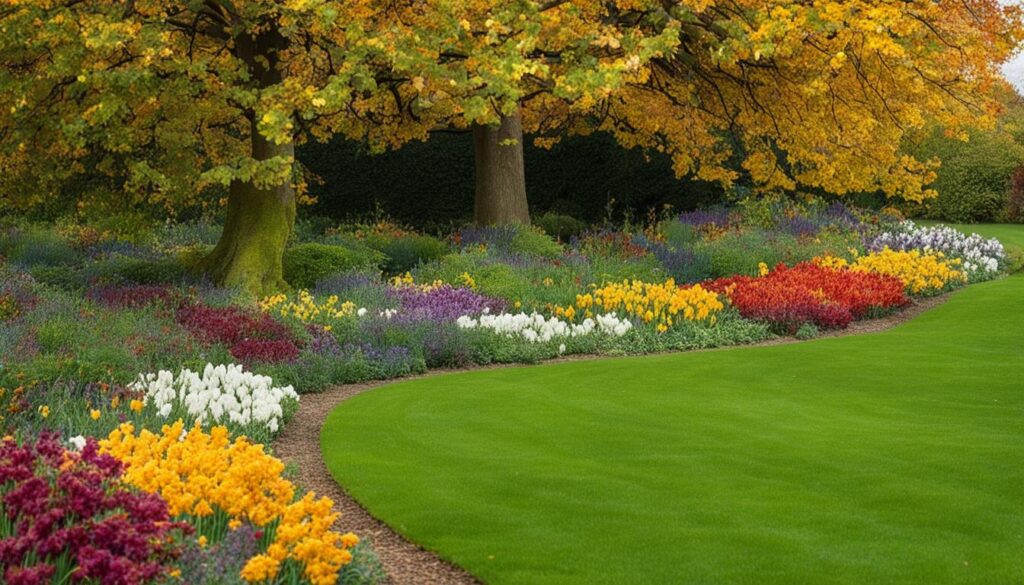
How to Grow Bulbs in the UK
Growing bulbs in the UK can be a rewarding and beautiful experience. With the right techniques and care, you can enjoy a stunning display of flowers throughout the year. In this guide, we will provide you with expert tips and advice on how to successfully grow bulbs in the unique climate of the UK. Whether you are a beginner or an experienced gardener, these tips will help you achieve stunning blooms in your garden.
Key Takeaways
- Choose bulbs that are suitable for the UK climate and specific growing conditions.
- Plant bulbs at the right time and depth to ensure successful growth.
- Proper care, including watering, feeding, and pruning, is essential for bulb health.
- Be aware of common problems and pests that can affect bulb growth in the UK.
- Consider succession planting to extend the blooming season and create a diverse garden.
Benefits of Growing Bulbs in the UK
Growing bulbs in the United Kingdom comes with a multitude of benefits that make it a popular choice for avid gardeners. Whether you’re a seasoned pro or just starting out, here are some compelling reasons why you should consider bulb gardening in the UK:
1. Wide Variety of Bulbs
One of the greatest advantages of UK bulb gardening is the incredible diversity of bulbs that thrive in the UK climate. From cheerful daffodils and vibrant tulips in the spring to elegant lilies and striking gladioli in the summer, there is a bulb for every season. This wide range allows you to create stunning displays that evolve and change throughout the year, bringing constant joy to your garden.
2. Low Maintenance
Bulbs are known for their low maintenance nature, making them ideal for busy gardeners or those new to gardening. Once established, bulbs require minimal care, allowing you to enjoy their beauty without constant upkeep. They are a reliable and fuss-free addition to any garden, requiring only occasional watering and basic feeding to thrive.
3. Easy Propagation
Another advantage of growing bulbs in the UK is their ease of propagation. Bulbs naturally multiply over time, creating larger, more abundant displays. This means you can expand and diversify your collection without having to invest in new bulbs each year. It’s a cost-effective way to enhance the beauty of your garden and explore new varieties.
4. Pollinator Friendly
Bulbs are beloved by pollinators such as bees and butterflies. By growing bulbs in your UK garden, you’re providing a valuable food source and habitat for these essential creatures. Not only does this support biodiversity, but it also adds a vibrant and dynamic element to your outdoor space, with a constant flurry of pollinator activity.
5. Visual Interest
By incorporating bulbs into your garden, you introduce captivating visual interest and texture. Their variety of shapes, sizes, and colors create eye-catching focal points and dynamic contrasts. Whether planted in borders, pots, or naturalized in meadows, bulbs bring a touch of magic and charm to any landscape.
With all these benefits, it’s no wonder that UK gardeners are passionate about growing bulbs. Not only do they offer a stunning display of flowers throughout the year, but they also provide a low-maintenance, pollinator-friendly addition to your garden landscape. So why wait? Start your bulb gardening journey and enjoy the many rewards it brings.
Choosing the Right Bulbs for UK Growing
When it comes to choosing bulbs for UK growing, it’s important to select varieties that are well-suited to the unique climate and conditions of the United Kingdom. Whether you’re looking to create a vibrant floral display in your garden or add pops of color to your landscape, selecting the right bulbs is crucial for successful and beautiful growth.
Here are some essential tips to help you choose the best bulbs for UK gardens:
Consider the Specific Needs and Requirements
Not all bulbs have the same preferences when it comes to sunlight, soil type, and moisture. Some bulbs thrive in sunny spots with well-draining soil, while others can tolerate shade or damp conditions. Consider the specific needs of each type of bulb and choose varieties that will flourish in the conditions of your garden.
Select Bulbs Suitable for the UK Climate
While there is a wide variety of bulbs available, not all are suitable for the UK climate. It’s important to choose bulbs that can withstand the colder temperatures and natural fluctuations in weather that are characteristic of the UK. Look for bulbs that are known to perform well in the UK climate, ensuring they are able to withstand frost and cold snaps.
Flowering Time, Height, and Color
Another important factor to consider when choosing bulbs is their flowering time, height, and color. By selecting bulbs with different flowering times, you can ensure a continuous display of blooms throughout the year. Consider the height and color of the bulbs to create visually appealing combinations and designs in your garden. A mix of heights and colors can add depth and interest to your flower beds.
Remember, choosing the right bulbs is the first step towards a successful and beautiful garden. By considering the needs of each type of bulb, selecting varieties suitable for the UK climate, and paying attention to flowering time, height, and color, you can create a cohesive and stunning display in your garden or landscape.

Planting Bulbs in the UK
Planting bulbs in the UK requires careful timing and attention to detail. By following the step-by-step bulb planting guide below, you can ensure successful growth and beautiful blooms in your garden.
- Choose the Right Bulbs: Select bulbs that are suitable for the UK climate and the specific conditions in your garden. Consider factors such as flowering time, height, and color to create a stunning display.
- Timing: Most bulbs are planted in the autumn, allowing them to establish their roots before winter. However, some summer-flowering bulbs can be planted in the spring. Consult the packaging or bulb planting guides for specific timing recommendations.
- Planting Depth: The planting depth varies depending on the type of bulb. As a general rule, plant bulbs at a depth equal to three times their height. This helps to ensure proper growth and blooming.
- Soil Preparation: Prepare the soil by removing any weeds or debris and loosening it with a garden fork. Ensure that the soil is well-drained and enriched with organic matter, such as compost or well-rotted manure.
- Planting: Dig a hole or trench that is wide enough to accommodate the bulbs and their roots. Place the bulbs in the hole with their pointed ends facing up, and gently cover them with soil. Space the bulbs according to the recommended spacing guidelines on the packaging.
Proper watering and feeding techniques are also crucial for the successful growth of bulbs. Water the newly planted bulbs thoroughly, and continue to water them regularly during dry spells. Apply a high-potassium fertilizer to promote good flowering in the following year.
| Planting Bulbs in the UK: Step-by-Step Guide |
|---|
Following these planting guidelines and providing proper care will help your bulbs thrive and produce stunning blooms in your UK garden.
Caring for Bulbs in the UK
Proper care is essential for the health and longevity of bulbs in the UK. By following these expert tips and guidelines, you can ensure that your bulbs thrive and provide a stunning display of flowers in your garden.
Watering
Bulbs need regular watering while in growth, especially during dry spells. It’s important to water thoroughly and allow the soil to become slightly damp between waterings. This will ensure that the bulbs receive enough moisture to develop strong roots and produce vibrant blooms.
Fertilizing
Feeding your bulbs with a high-potassium fertilizer is recommended to promote good flowering in the following year. This will provide the necessary nutrients for healthy growth and help the bulbs produce larger, more beautiful flowers. Be sure to follow the instructions on the fertilizer packaging for the proper application.
Deadheading and Cutting Back Foliage
Deadheading spent flowers and cutting back foliage at the appropriate time will encourage the bulbs to focus their energy on storing nutrients for the next growing season. Removing faded flowers and yellowing foliage also improves the overall appearance of the garden and prevents the spread of diseases.
Overwintering
Properly overwintering bulbs is crucial to protect them from harsh weather conditions. Before the first frost, dig up any tender bulbs and store them in a cool, dry place. Hardy bulbs can be left in the ground, but adding a layer of mulch over the planting area will provide extra insulation and protection.
Bulb Care Checklist
| Care Task | When to Do |
|---|---|
| Watering | Regularly during growth, especially in dry spells |
| Fertilizing | In early spring and after flowering |
| Deadheading | As soon as flowers fade |
| Cutting Back Foliage | After foliage turns yellow and dies back naturally |
| Overwintering | Before the first frost |
Common Problems for Bulbs in the UK
While bulbs are generally low maintenance, they can still face some common problems in the UK. Here are some of the issues you may encounter when growing bulbs in your garden:
Pests
Pests like slugs, snails, and squirrels can be a nuisance and cause damage to your bulbs, especially tulips and crocus. Slugs and snails are particularly fond of the tender leaves and flowers, leaving behind unsightly holes and damage. Squirrels can dig up bulbs, mistaking them for food, which can disrupt their growth.
Diseases
There are several diseases that can affect bulb growth in the UK. Some common diseases include:
- Daffodil viruses
- Grey mould in snowdrops
- Narcissus basal rot
- Tulip fire
- Tulip viruses
These diseases can cause wilting, discoloration, deformation, and other signs of distress in your bulbs, affecting their overall health and appearance.
It’s important to check your bulbs for signs of rot or disease before planting them in your garden. Avoid using bulbs that show any signs of damage or disease, as they can spread and infect other healthy bulbs.
Pest and Disease Control
Proper garden hygiene and regular inspection are key to preventing and controlling pests and diseases. Here are some tips to help you mitigate these common problems:
- Remove any decaying plant material from the garden to reduce the risk of pests and diseases.
- Maintain good airflow and avoid over-crowding bulbs, as this can create a favorable environment for diseases.
- Consider using physical barriers like netting or wire mesh to protect bulbs from pests like squirrels.
- Apply organic pest control methods, such as using beer traps or copper tape to deter slugs and snails.
- If necessary, consult with a professional gardener or horticulturist for specific pest and disease control measures.
Remember to always follow the instructions on any pest or disease control products you use and handle them with care.
By taking these preventative measures, you can enjoy healthy and vibrant bulbs in your UK garden.
| Pests | Diseases | Pest and Disease Control |
|---|---|---|
| Slugs | Daffodil viruses | Remove decaying plant material |
| Snails | Grey mould in snowdrops | Maintain good airflow |
| Squirrels | Narcissus basal rot | Use physical barriers |
| – | Tulip fire | Apply organic pest control methods |
| – | Tulip viruses | Consult with a professional gardener |
Extending the Blooming Season with Bulbs in the UK
In the UK, you can enjoy the beauty of blooming flowers for an extended period by strategically planning your bulb planting. By selecting a variety of bulbs that bloom at different times throughout the year, you can create a captivating display that lasts from early spring to late autumn.
To prolong the flowering period, consider planting bulbs that flower in different seasons. Choose early-flowering bulbs like snowdrops and crocuses to brighten up your garden in the early spring. These delicate flowers add a splash of color when most of the garden is still waking up from winter dormancy.
In the mid-season, focus on bulbs like daffodils and tulips. These classic beauties bring vibrant hues and a burst of energy to your garden, signaling the arrival of warmer weather. With their variety of sizes and colors, daffodils and tulips can transform any space into a lively, blooming oasis.
For late-season blooms, consider planting bulbs such as alliums and lilies. These majestic flowers add height and drama to your garden, creating a stunning backdrop for your outdoor space. As the summer comes to an end and the days shorten, these late bloomers provide a final burst of color that lingers until autumn.
Another technique to extend the blooming season is succession planting. Instead of planting all your bulbs at once, stagger their planting times throughout the year. By doing so, you can ensure a continuous cycle of blooms throughout the different seasons. This method works particularly well for bulbs like tulips, daffodils, and hyacinths.
When planning your succession planting, consider the flowering time, height, and color of each bulb variety. This way, you can create a harmonious and visually appealing garden that evolves and thrives with each passing season.

Benefits of Extending the Blooming Season
- Enjoy a continuous display of vibrant blooms throughout the year
- Create a visually appealing garden that evolves and changes with each season
- Maximize the beauty and impact of your outdoor space
- Attract pollinators and beneficial insects for a thriving ecosystem
- Extend your enjoyment of gardening and the outdoors
By extending the blooming season with bulbs in the UK, you can transform your garden into a breathtaking and ever-changing landscape. With careful planning and selection, you can create a haven of beauty and color that brings joy and inspiration to your outdoor space.
Conclusion
Congratulations on reaching the end of this comprehensive guide on growing bulbs in the UK! We hope you’ve gained valuable insights and tips to enhance your bulb gardening experience. With the right techniques and care, you can successfully cultivate a wide variety of bulbs in your garden, adding beauty and color throughout the year.
Throughout this guide, we have covered everything you need to know, from choosing the right bulbs for the UK climate to planting, caring, and troubleshooting common problems. By following these expert tips and techniques, you can create a stunning display of colorful blooms that will transform your outdoor space.
Remember to carefully select bulbs suitable for the UK climate, consider their specific needs, and provide proper care and maintenance. Watering, feeding, and protecting bulbs from pests and diseases are essential for their health and longevity. With a little effort and attention, you can enjoy the beauty and joy of bulbs blooming in your garden throughout the seasons.
So, why wait? Get started on your UK bulb gardening journey and enjoy the rewarding experience of watching your garden come to life with vibrant flowers. Happy gardening!
FAQ
How do I choose the right bulbs for UK growing?
When choosing bulbs for UK growing, consider their specific needs and requirements, as well as the UK climate. Select bulbs that thrive in sunny or shaded conditions and ensure they are suitable for the colder temperatures. Choose bulbs that flower at different times to create a cohesive display in your garden.
When is the best time to plant bulbs in the UK?
Most bulbs are planted in the autumn, while some summer-flowering bulbs can be planted in the spring. Timing is crucial for successful bulb growth, so make sure to plant them at the right time of year.
How deep should I plant bulbs in the UK?
The planting depth of bulbs in the UK depends on the type of bulb. As a general guideline, plant bulbs at a depth equal to three times their height. This will ensure they are properly established and have enough soil coverage.
What care do bulbs need in the UK?
Bulbs in the UK require regular watering during growth, especially in dry spells. Water thoroughly and allow the soil to become slightly damp between waterings. Feeding with a high-potassium fertilizer will promote good flowering in the following year. Deadhead spent flowers and cut back foliage at the appropriate times to help bulbs thrive. Proper overwintering is also important to protect them from harsh weather conditions.
What are the common problems for bulbs in the UK?
Bulbs in the UK can face common problems such as pest damage from slugs, snails, and squirrels, as well as diseases like daffodil viruses, grey mould, narcissus basal rot, tulip fire, and tulip viruses. Check bulbs for signs of rot or disease before planting and take appropriate pest and disease control measures.
How can I extend the blooming season with bulbs in the UK?
To extend the blooming season in the UK, choose early, mid, and late-season flowering bulbs. Plant them at different times throughout the year using succession planting techniques. This will ensure a continuous display of blooms from early spring to late autumn.